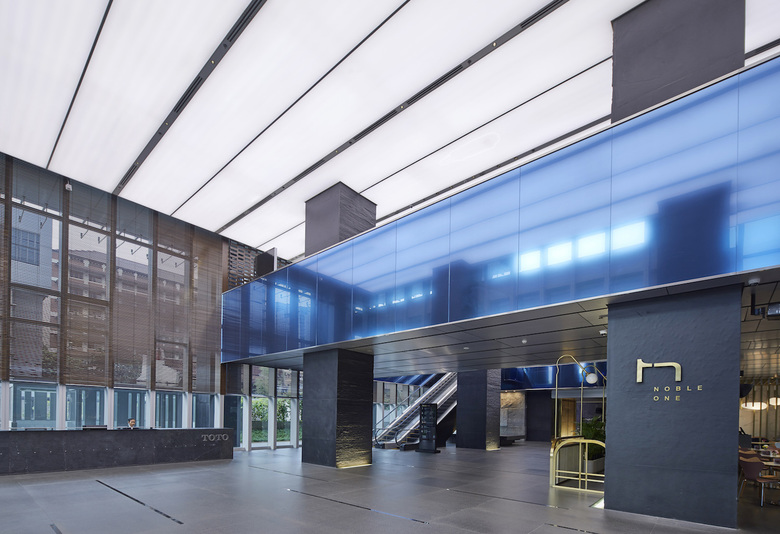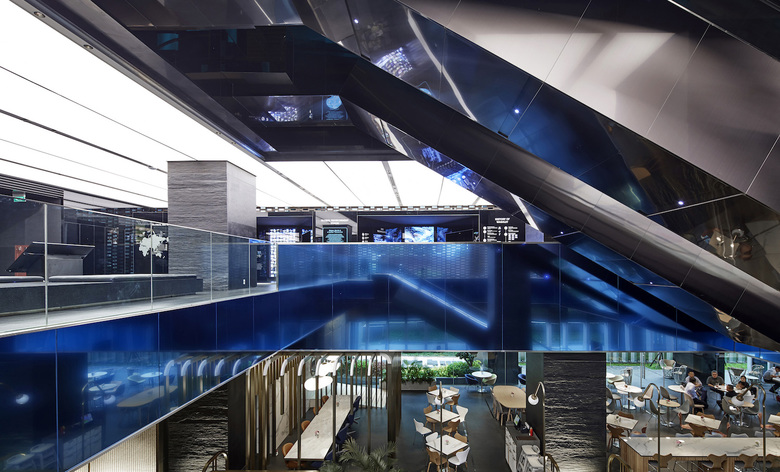TOTO Indonesia HQ
Field Four Design Office
26. Juni 2019
Photo: Hiroshi Tsujitani / Nacasa & Partners
Late last year, TOTO, the world-famous toilet manufacturer from Japan, opened its Indonesian headquarters inside a brand new office building on Letjen S. Parman Street in Central Jakarta. Field Four Design Office answered a few questions about their design of TOTO's showroom and offices.
Location: Jakarta, Indonesia
Client: PT Surya TOTO Indonesia
Interior Design: Field Four Design Office, Tokyo
Architecture: Airmas Asri Architects
Lighting Design: Lumina group
Construction: Shimizu Corp.
Floor Area: 20,250 m2
TOTO’s corporate color welcomes guests in the entrance. (Photo: Hiroshi Tsujitani / Nacasa & Partners)
Please give us an overview of the project.Located in central Jakarta, the new headquarters and showrooms of TOTO Indonesia consists of showrooms for customers and architects on the lower levels (2nd through 5th floors) and offices on the upper levels (6th through 15th floors). The showrooms are designed to let visitors experience the interplay of light and water against the context of the strong sunlight and hustle and bustle of the growing city outside. In the entrance, water reflecting the city lights references TOTO’s corporate color, while the walls alongside the escalators that connect each of the showroom floors showcase the play of light on flowing water and the showrooms themselves feature the still light of a pond. The goal was for these spaces to evoke the luxury that pure, fresh water brings to daily life. On the upper floors, high-quality work spaces incorporate the reflectivity and translucence of pure water, embodying the company’s image.
The Technical Center on the second floor. (Photo: Hiroshi Tsujitani / Nacasa & Partners)
What was most important for you during the design process?In order to make sure the products on display took center stage in the showroom while the space and architecture served as a backdrop, we modulated the strong southeast Asian sunlight and omitted all showy decorative elements. At the same time, we concentrated on creating unique spatial experiences in the transition spaces between showrooms, expressing the company’s focus on water and leaving a strong impression on visitors.
TOTO’s latest products and pioneering technologies are displayed in the Technical Center. (Photo: Hiroshi Tsujitani / Nacasa & Partners)
What challenges did you face in the project? How did you respond to them?In overseas projects such as this one, labor tends to be clearly divided according to the specialization of each company or contractor. However, in this project, we worked hard to collaborate and communicate with the other companies involved, actively reaching out in order to improve the quality of the architecture. For example, we rethought the floor plan and sections from an interior design perspective, changing the location of double-height ceilings and other features and working closely with the client to determine the final layout.
In order to spotlight the company’s image and products, the showroom is free of decorative elements. (Photo: Hiroshi Tsujitani / Nacasa & Partners)
What did you learn from this project? What will you take from it to future projects?Construction and fabrication methods vary between countries and regions, as do materials themselves. This project was an opportunity for us to reflect once again on how to incorporate and assimilate these differences into our design.
Email interview conducted by Ryogo Utatsu, Japan-Architects.











